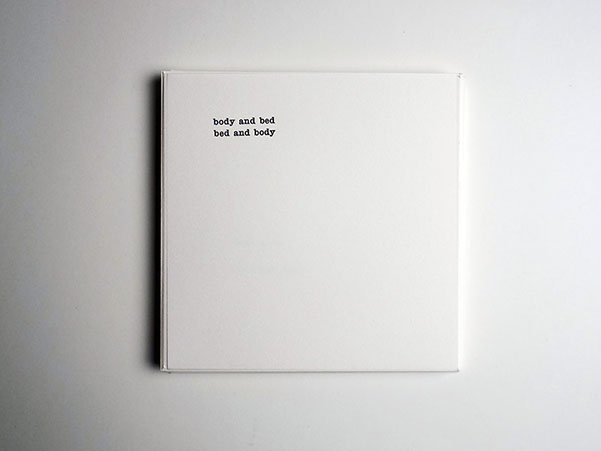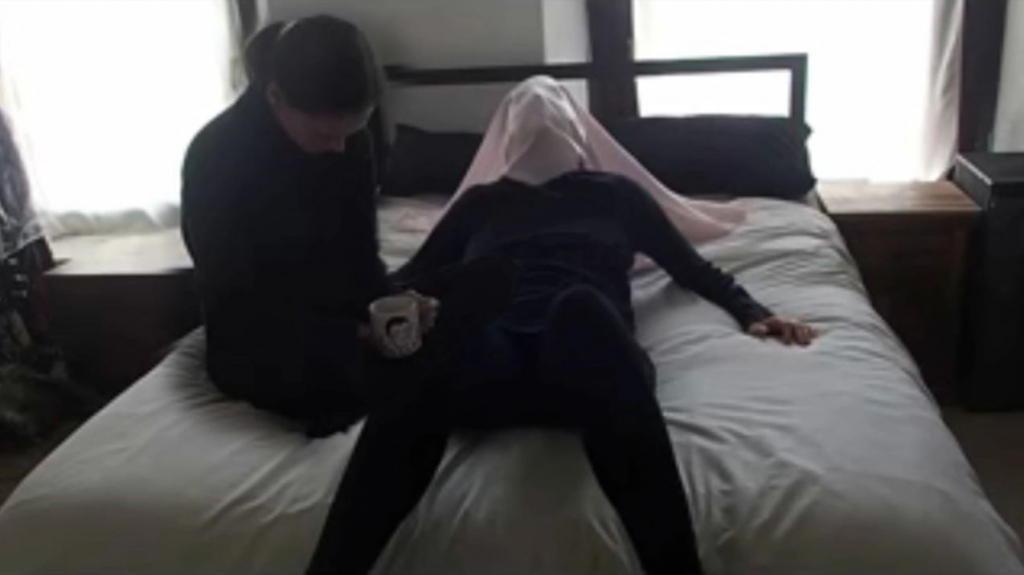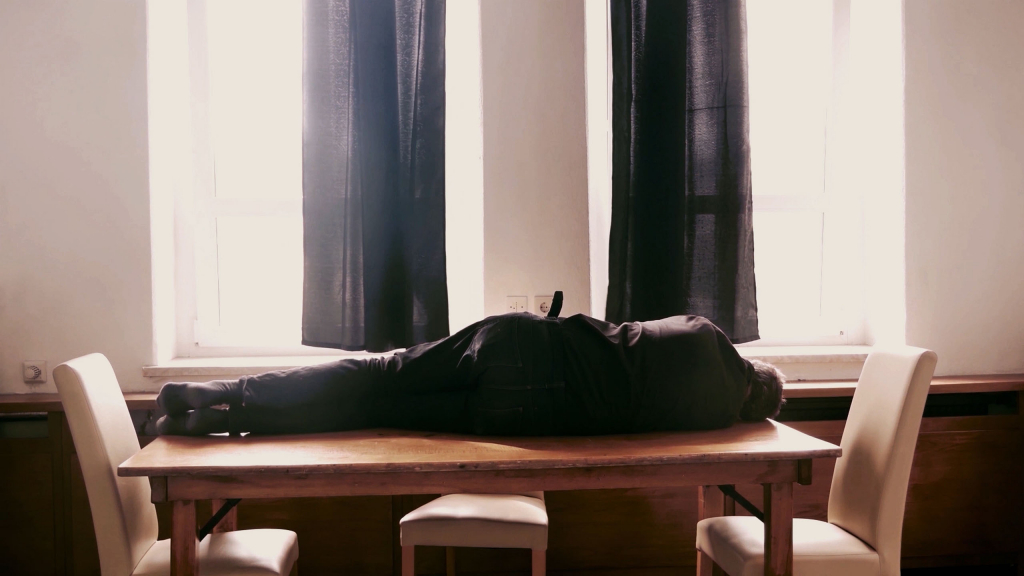Curated by Bella Kerr, Caroline Humphreys & Amanda Roderick
for Oriel Y Bont, April – September 2025
Directly the bed is called for, or, sunk deep among pillows in one chair, we raise our feet even an inch above the ground on another, we cease to be soldiers in the army of the upright; we become deserters. They march to battle. We float with the sticks on the stream; helter-skelter with the dead leaves on the lawn, irresponsible and disinterested and able, perhaps for the first time for years, to look round, to look up – to look, for example, at the sky.
– Woolf, Virginia On Being Ill, p.37 (Hogarth Press: London, 1926)
This exhibition will examine the relationship between chronic illness and making and will feature new work by Welsh artists in combination with the work of artists from elsewhere, providing a Welsh focus within a UK wide and international context.
The idea of ‘good health’ has obvious merit – but what about the value of ill health? Sue Asbee observes that; ..a major illness forces the need to renegotiate our relationship with our bodies and with the world. Things that we took for granted when we were well are inconceivably impossible once we are not’. 1 Can illness embolden creativity? Can creativity soothe pain? How do forms of quiet withdrawal from society – by refuseniks, drop-outs, ‘quiet quitters’ and the ill – expand the field of creative awareness? Artists were invited to submit a body of work to explore how illness can both disrupt and shape identity2 and practices.
Life changing sickness is a commonality that connects many artists’ otherwise disparate practices across decades, genres and lifetimes.3 Artists and writers ranging from Agnes Martin, Derek Jarman, Donald Rodney, Frida Kahlo and Virginia Woolf, have depicted suffering, producing affecting accounts of illness and ‘turning care into the deepest subject of [their] art’. 4 Witness to the ‘taboos and social stigma surrounding illness’,5 artists have gained agency over their medical conditions to reimagine ‘the parameters of bodily trauma, reconciling trauma with recovery’.6 Recent cultural discourse has examined chronic illness, challenging its conventional representations and celebrating health diversity. 3 It asks the question; ‘What conditions might actively nurture creative and participatory instincts? 7
Illness is a part of every human being’s experience. It enhances our perceptions and reduces self-consciousness. It is the great confessional; things are said, truths are blurted out which health conceals.8
We are constructing a dedicated website for this project, a YouTube channel and social media accounts – and will also be producing both a digital catalogue. These will include, in addition to the artists showing work in the physical space of the gallery, an equal number who will be featured digitally only, at this stage. This decision grew from an understanding that some artists cannot install or attend in person due to their state of health, and also from the intention that this will be an ongoing project, supported by the longevity and reach that online digital expression offers. We also intend to host round table discussions as part of the exhibition, bringing together artists, health practitioners and others. These events will provide the material for a podcast(s) as a resource for health practitioners, curators and artists, and the communities surrounding loved ones with lived experience of chronic illness.

Oriel Y Bont provides a unique context for this exhibition, as the campus and USW are home to the BA in Creative and Therapeutic Arts, MA Arts in Health and Wellbeing and the George Ewart centre for Storytelling. We hope that liaising with staff and students through collaborative timetabling of events will enrich discussion and the educational experience. The selection of artists reveals a tender delicacy of line, colour and form, combined with some chaos. Clarity of statement is combined with elements that capture confusion – the scattered, spilling out, fluid nature of ill health and the way it takes over the body, and the whole exhaustive nature of illness and the need to find rest and recalibrate. The themes and modes that have emerged can be broadly described as: abstraction, repetition and pattern making; nature and healing; lying down while the world stands up; the body – whole and in parts; text and form filling.

Deserters has grown from conversations with previous artists, who took part in our exhibitions The Coming of Age and Who’s Been Sleeping in My Bed?, and with Caroline Humphreys, who is now co-curating Deserters with Bella Kerr, alongside Amanda Roderick who is creating its online presence. The curators hope to further develop the conversation with exhibitors through the digital catalogue as a ‘long life’ version of the project
Image credits (from top):
Heart by Katya Robin (Drawing)
Body and bed bed and body by Charlotte Morgan (Letterpress)
i am here now by Jenny Alderton (still from video)
The Healing by Johannes Gerard (still from video)

References
1 Pratt, Jim (ed), The Nightingale Silenced: and other unpublished writings by Margiad Evans (Welsh Womens Press)
2 Sontag, Susan Regarding the Pain of Others (Penguin, 2003)
3 The Wellcome Collection Misbehaving Bodies (September 2018 – January 2020, London)
4 Godfrey, Mark, Turner Prize 2018 catalogue, p.70-74 (Tate Gallery; London, 2018 )
5 Morgan, Stuart ‘Borrowed Time’ from Derek Jarman: A Portrait, p.118-120, (Thames and Hudson: London, 1996)
6 Miller, Peter Donald Rodney and the Cyborg, Paul Mellon Centre Notes No.25, p.19 (London, 2023)
7 Hauser & Wirth Hospital Rooms Holding Space 17 August – 12 September 2023, (London, p.2)
8 Woolf, Virginia On Being Ill , (London: Hogarth Press, 1926)
9 Sontag, Susan Illness as Metaphor (1977)
10 Woolf, Virginia On Being Ill (Hogarth Press: London, 1926)
11 Popova, Maria Virginia Woolf on Being Ill as a Portal to Self-Understanding, The Marginalian, 2023
Further Reading
Bhalla, Niamh Experiencing the Last Judgement (Routledge: London, 2021)
Bhalla, Niamh Birth, death and protective imagery in a rock-hewn church from tenth-century Cappadocia (The Courtauld; London, 2023)
Bohata, Kirsti ‘The Apparitional Lover’ from Rediscovering Margiad Evans: Marginality, Gender and Illness p.111 (University of Wales Press; Cardiff 2013)
Caesar, Karen ‘Warding off the Real’ from Rediscovering Margiad Evans: Marginality, Gender and Illness p. 142 (University of Wales Press; Cardiff 2013)
Cary-Parkes, James ‘Et In Arcadia…Homo’ from Derek Jarman: A Portrait p.138 (Thames & Hudson: London, 1996)
Douglas, Caroline, ‘Precious and Splendid Fossils’ from Beyond Reason: Art & Psychosis, Works from the Prinzhorn Collection, p.42 (Hayward Gallery, London 1997)
Gramich, Katie ‘Gothic Borderlands’ from Rediscovering argiad Evans: Marginality, Gender and Illness p. 61 (University of Wales Press; Cardiff 2013)
Hattrick, Alice Ill feelings, Stories of Unexplained Illness (2017)
Herbert, Martin, Tell them I said No (Sternberg Press: 2016)
Sackville West, Vita Solitude, The Hogarth Press, London, 1938
The Rejectionists, The Drawing Center & Pace Gallery; New York, Oct 25 – Nov 8, 2023. https://drawingcenter.org/programs/2023-benefit-auction and https://www.pacegallery.com/the-rejectionists/


